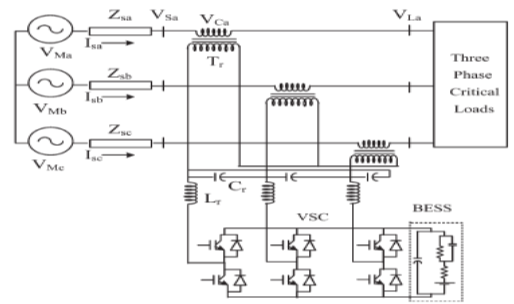Control of Reduced-Rating
Dynamic Voltage Restorer with a Battery Energy Storage System
ABSTRACT:
In this paper, different voltage injection schemes
for dynamic voltage restorers (DVRs) are analyzed with particular focus on a
new method used to minimize the rating of the voltage source converter (VSC)
used in DVR. A new control technique is proposed to control the
capacitor-supported DVR. The control of a DVR is demonstrated with a reduced-rating
VSC. The reference load voltage is estimated using the unit vectors. The
synchronous reference frame theory is used for the conversion of voltages from rotating
vectors to the stationary frame. The compensation of the voltage sag, swell,
and harmonics is demonstrated using a reduced-rating DVR.
KEYWORDS:
1.
Dynamic
voltage restorer (DVR)
2.
Power quality
3.
Unit vector
4.
Voltage
harmonics
5.
Voltage sag
6.
Voltage swell
SOFTWARE: MATLAB/SIMULINK
BLOCK DIAGRAM:
Fig.1.
Schematic of the DVR-connected system.
CONCLUSION:
The
operation of a DVR has been demonstrated with a new control technique using
various voltage injection schemes. A comparison of the performance of the DVR
with different schemes has been performed with a reduced-rating VSC, including a
capacitor-supported DVR. The reference load voltage has been estimated using
the method of unit vectors, and the control of DVR has been achieved, which
minimizes the error of voltage injection. The SRF theory has been used for estimating
the reference DVR voltages. It is concluded that the voltage injection in-phase
with the PCC voltage results in minimum rating of DVR but at the cost of an
energy source at its dc bus.
REFERENCES:
[1]
M. H. J. Bollen, Understanding Power Quality Problems—Voltage Sags and
Interruptions. New York, NY, USA: IEEE Press, 2000.
[2]
A. Ghosh and G. Ledwich, Power Quality Enhancement Using Custom Power
Devices. London, U.K.: Kluwer, 2002.
[3]
M. H. J. Bollen and I. Gu, Signal Processing of Power Quality Disturbances.
Hoboken, NJ, USA: Wiley-IEEE Press, 2006.
[4]
R. C. Dugan, M. F. McGranaghan, and H. W. Beaty, Electric Power Systems
Quality, 2nd ed. New York, NY, USA: McGraw-Hill, 2006.
[5]
A. Moreno-Munoz, Power Quality: Mitigation Technologies in a Distributed Environment.
London, U.K.: Springer-Verlag, 2007.
